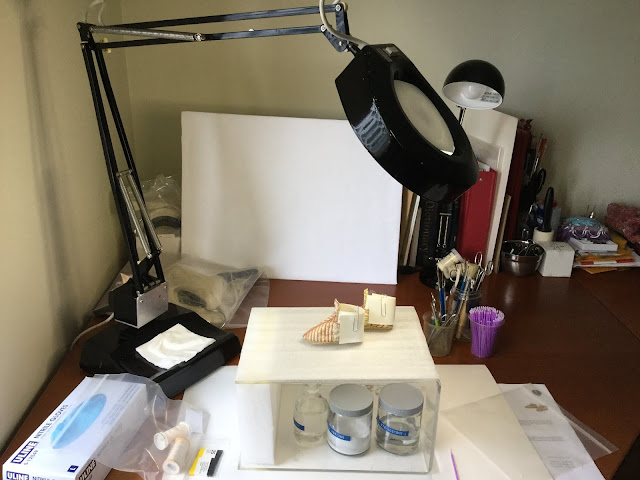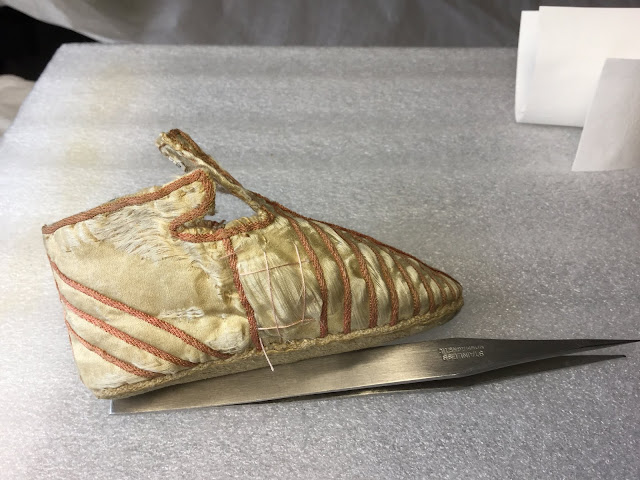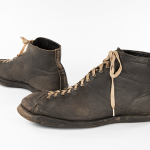Due to the current situation of COVID-19, the BSM staff has been getting creative on how to bring you the BSM From Home! Our conservator, Ada, has turned her home office into a temporary work space! Find out more about the process in today’s blog post written by her.
My plan was to continue conservation on easily transportable artefacts to be displayed in the upcoming 18th century exhibition, The Great Divide. The selection of tools was based on the first two projects, a pair of baby shoes and a fragment of Indian cotton. The magnifying lamp is necessary for fine hand stitching; the padded acrylic stand elevates small artefacts to a comfortable working height; smaller tools (micro brushes, hair silk, tweezers, curved surgical scissors, beading needles) are items I keep on my desk at the museum as they are used on a regular basis. There are three artefacts awaiting treatment: a bound foot shoe, a pair of baby’s shoes and a fragment of chintz, an Indian cotton fabric. Today we will focus on the bound foot shoe and a pair of baby’s shoes.

The bound foot shoe has large losses on one side of the silk satin upper and cotton lining which need to be replaced in order to stabilize that side of the shoe. While I have both fabrics, I am unable to attain the dyes as the supplier has been deemed a non-essential service, having closed up shop until the COVID-19 restrictions are lifted. It would be possible to purchase them online but it is easier to select a colour when you are able to see the end result in person. This project will wait until this current situation has normalized.
The baby shoes are originally from England and were made around 1730 – 1750. They have an ivory silk satin upper decorated with cotton braid, lined with linsey-woolsey, a fabric woven with a linen warp and a wool weft. The warp is composed of the lengthwise fibres through which the crosswise weft is woven. The satin is desiccated and there are losses with loose fibres protruding from its surface. The original colour of the braid was a vibrant pinky red which is visible on its underside where it was protected from exposure to light which has faded the upper side to a very pale grey-pink. The quarters of the shoes, the back section that wraps around the sides of the heel area, are wrinkled and misshapen.

The first step, which was completed earlier in January at the museum, involved reshaping the quarters by passive humidification. This technique used dampened acid-free blotting paper placed over a perforated polyester film then covered with a small piece of plastic sheet to slow down the evaporation of the moisture.
Next the fabric losses, primarily on the quarters, were supported with a satin of similar weight and colour. The template of each satin infill was created by placing a piece of polyester over the area of loss, then drawing the outline onto the film.



These patterns were transferred onto the satin which was inserted behind and underneath the losses with fine-tipped tweezers, then the fill was loosely basted to the lining to keep it in place prior to the final stitching. The satin fills and the surrounding loose fibres were stitched in place using single strands of hair silk and a fine beading needle. The hand sewing took many hours working under a magnifying lamp. Come and see the finished treatment in the exhibition which we hope to install this fall, fingers crossed!


